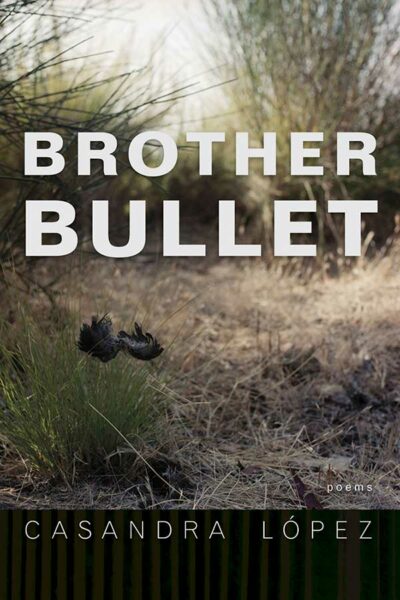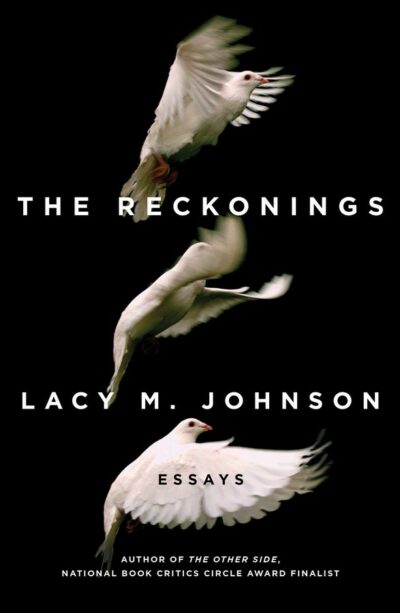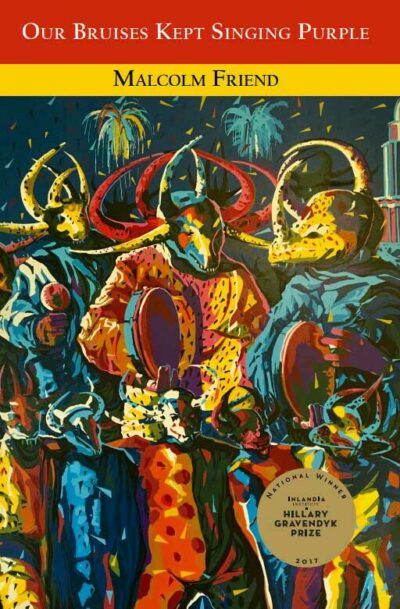Brother Bullet by Casandra López
(University of Arizona Press, 2019)
López’s collection is a careful and intimate study of grief in relationship to gun violence. López observes how violence (being a victim of it, witnessing it, and surviving it) becomes part of our intersecting identities. Her book is broken into four sections: Bullet Breaks, Bullet Teaches, New Language, and Remains. Through this structure, a reader is led to López’s split self: before trauma, and after trauma. The book gains speed as it moves towards the central question: what’s left with us after violence takes from us? Our speaker opens with a formal invitation, “Come—” and this deceptively simple opening invites us in to the book itself as a creator of community; reading it allows for that creation. We are engaged in the book’s act of storytelling after the invite. “See where Bullet broke/Brother, see where I break/where we split into before/ and after. We fracture…(5).” She asks us to go with her on this journey. López’s use of repetition of the word “break” works literally and figuratively along with her line breaks to enact the fractured moment her brother is murdered. These breaks set the tone for the text. López uses capitalization and personification to highlight gun violence as a concrete entity. “And I try to imagine Bullet being questioned,” she writes, and this personification of violence is something that persists for the duration of the text, reminding us that this problem is larger than the person who murders, it is the violence itself and the society in which it manifests. The text shows the ways in which being a victim of violence can blot out identity.
“Nurses type out: D A V I D D O E/ plastic to wrist, you are renamed./ They said it was for your protection. How unsafe/ the hospital felt, this world./ We are told in the afterlife our ancestors/ will know our name—sometimes I believe (52).”
Repeated words and images haunt the collection: cars, a blue door, DNA, citrus fruit, the ocean, break (figurative and literal), Bullet (personified and actual), and Brother. The repetition mimics the grief itself—intrusions and setbacks, obsessions, meditations, and the inability to move forward from certain words shows the reader how nonlinear the process of grieving can be.
López is trying to do in her work what many people say is impossible; trying to make sense of something senseless; trying to learn from gun violence—a lesson the U.S. keeps failing to do over and over again.
She ends the collection addressing her brother directly, “isn’t this how you would want it?(92)” She tells us about his children, how they continue to grow and live without him despite the trauma.
“I need these reminders of/how we survive and still grow/ so fiercely against the edges of this earth (92).”
We are lucky she has invited us in to see her love, her family, her trauma, her pain, her Brother, her grief process, because she brings us closer to gun catharsis.
The Reckonings by Lacy M. Johnson
(Scribner, 2018)
“Violence changes the person who survives to see it, sometimes by making us more capable of violence ourselves (34.)” Lacy M. Johnson writes in her new book of essays that was a National Book Critics Circle award finalist. Close to López’s subject matter, this book of essays asks large looming questions about how to push society through experiences of violence and pain via the act of “reckoning” to a place of understanding. I first encountered Johnson’s work by reading her memoir The Other Side a few years ago and was struck by how profound and complex a book it was from tackling abuse to the way it was structured and how that form underlined some of the content. In this book of essays, we find more traditionally structured pieces that harken back to Michel de Montaigne (in a good way!) with the way she spins one concept around tackling it from many angles. Each essay is a lyrical composite of self, experiences, current events, crimes, research, and meaning making. These essays are more investigative and Socratic than lyric, but their movement is often non-linear. She offers up insight and fresh thought on problems plaguing American culture today. “More than anything else, what I want is a reckoning. Not only for myself, not only for him (11).” Johnson brings restorative justice into the on-going conversation about her own rape and kidnapping. “I never imagined shooting him in a way that might kill him, never in the heart, never in the head, in the face. How could I destroy someone I had once loved? (36).” she asks at one point—illustrating the controversial gray areas that can exist between an abuser and victim. Johnson is at her best when she shows us nuance. Because this book does continue the conversation she started in her memoir we see that Johnson, STILL, years later, encounters people who doubt her experiences. “I learn at this moment that there are some people who will believe I am lying about what men have done to my body no matter what evidence I present to the contrary. I also learn it is not my responsibility to convince them…In the 1960’s, Betty Friedan called domestic oppression “the problem that has no name.” We might now call the epidemic of sexual violence against women the problem that has no language (92).” Her smart writing about power and sexual violence continues to be a strength in this book as well as her last.
It’s in her essay “Against Whiteness” that she declares, “It is pathological to see injustice and do nothing about it (124).” And this she categorizes as a condition of whiteness, a way to excuse oneself from witnessing the suffering of others. She argues well against this ideological whiteness, “Whiteness is a moral choice: if it is learned, we must unlearn it. If it is a transaction, we must refuse to buy in. If whiteness is a structure, it is vulnerable at its margins, like all built things we have responsibility to burn it down (126).”
We learn up front in the collection that our author is not interested in a system of justice which continues to create chains of pain, “more pain creates more sorrow, sometimes generations of sorrow, and it amplifies injustice rather than cancels it out (11).” Johnson and her essays call for something different, a world where we try to manage pain. A world where we open what has closed shut from agony and begin to let the light in.
Our Bruises Kept Singing Purple by Malcolm Friend
(Inlandia Books, 2018)
This brilliant collection which won the Hillary Gravendyk Prize in 2017 written in both English and Spanish vibrates with anthems, ironic odes, and energy that gain momentum through thought provoking discussion of identity as place, race, ethnicity, family history, music, and meditation. We travel through fragments, and meditations rooted in South End Seattle, Puerto Rico, and Pittsburgh. The speaker’s voice is as wise as it is tender as it darts through painful truths and experiences as much as it revels in and celebrates the sensory beauty of simply being alive. Friend’s connection to music interests me a great deal as someone who also finds inspiration there. His mentions of blues, Reggatón, salsa, bomba, Bob Marley and Sir-Mix-A-Lot help us access multiple layers of interior understanding about our speaker. Friend uses mythological figures of “Bomba Man” and “Blues Man” who show up in the book as important indicators of how one’s body becomes the battleground for identity. What does it mean to only search the body for identity? How is that a false place to “see” someone? Or a way to only get some of the story of identity? How does one fight through the limitations of body to show the entire self? How does one also celebrate the body that exists despite its inability to tell the whole story of identity? This is illustrated in Friend’s book through many of the poems but particularly in, “The Bomba Man and Blues Man Argue Over Who Has To Bury Malcolm’s Body” where the two mythological speakers fight over our author’s body: “His lengua is yours his arms are yours (86)”
By the end our speakers give Malcolm “what’s left” of himself and we are left picturing what could be left? What does it even mean to own oneself after culture, place, race, and ethnicity has warred and owned us so fully?
Friend’s work sings with effective line breaks creating drama in spaces as in, “Afro-Seattleite Fragment #1: Black Kid, White City” he writes, “As florescent lights in school hallways/(good schools are white)/white/as full feathered angel wings/(death is white)/you are not/white/you are/black/but your city is/white (53).” Or in the poem, “Reggatón as Sensible Form of Puerto Rican Therapy, or A Close Listening of Don Omar’s Hasta abajo” he writes, “3. Por eso andan revuelta/This space/be our riot/ all over the dance floor/our revolution./let’s degrade,/sweat a little more/sully these bodies/until we/are true sucios,/dirty as the music we dance to (39).”
Friend also confronts pervasive racist ideas from those that don’t believe Puerto Rico is part of the United States, to racist hierarchies of language, “In Spanish class,/ Patrick is confused,/ wants to know why/ dead American presidents/haunt Puerto Rican currency./ The instructor, Catalonian by birth,/ her accent more/ paella than mofongo,/ either does not know,/ or does not care—/ once told me to use/ “real” Spanish, that/ Española real,/ when I wrote Boricua/ to denote my origins (56).”
Friend’s work carefully reminds us that for a person of color in America how you see yourself is constantly challenged by how others react or see you. The daily tensions of self-knowledge being threatened by outside interpretations stretches over this collection. These moments of having to reckon with an outside interpretation of identity create an intensity allowing the poems themselves become songs of self- preservation and self-love. In a world that seeks to label or categorize what our author knows is more complex and more elusive than the language he wields he plays with labels and creates his own. In his poem, “Encyclopedia Entry: Afro-Seattelite,” our speaker seeks to define a label he has already used for half the book—something he admits is still undefinable, “data inconclusive as to whether this is Darwinian flaw on part of Seattlensis Africanus or suggests some sort of biological memory to the species’ ancestral habitats (55).” Friend already knows the more we seek to define and label, the larger and less definable we are. These poems are an expansion of the self. On each page the largeness, beauty, and complexity of a life lived looms.
Autobiography of Horse: A Poem
by Jenifer Sang Eun Park
(Gaudy Boy, 2019)
I rounded my summer reading out with this lovely obsession book. I’ve been interested in reading project books about one idea and this book is very successful. Readers are taken through what reads like one book-length dreamy poem on the topic of horses. We have so much play in form, photographs, diagrams, research, and a wise and whimsical speaker as our tour guide through the pages of horse obsession. Our speaker’s tone ranges in spectrum from guilt to sheer ecstasy about her obsession with horses—how even if she tries to stop the horses they visit her in every aspect of her life, they are the truth that she finds everywhere. “The horse was an answer to each prompt. In the horse’s body, I saw the possibilities of my own body. In the horse’s past, I saw my own past.” What is special about this collection is the very reveling in how obsession consumes us entirely—the joy of being swallowed completely. Park goes on to say, “and in Korean, 말, pronounced mahl, means “horse.” 말 also means “word,” “speech,” and “utterance.” This is some kind of destiny.” We start to realize horses are the very words she’s writing, each word a small horse galloping across the page. Another layer of pleasure is revealed when you leave Park’s book only to realize horses have invaded your life too.



